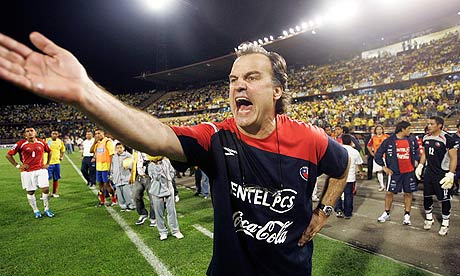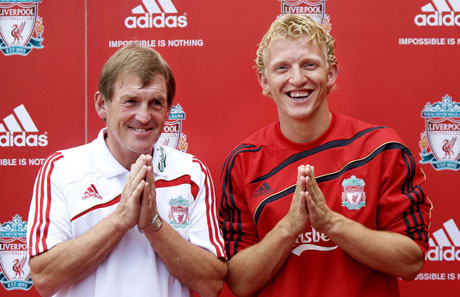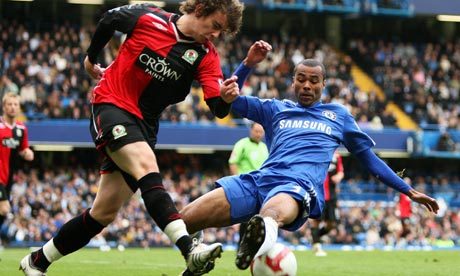-
Recent Articles
The Midfielder as Centerback
 Marcelo Biesla and Josep Guardiola are both managers who play a very high line with their respective sides and who both demand that all players be technically proficient with the ball. Part of playing...
Marcelo Biesla and Josep Guardiola are both managers who play a very high line with their respective sides and who both demand that all players be technically proficient with the ball. Part of playing...Understanding the 4-4-2 Diamond
DEFENCE Despite the fact that there are four ways to play a diamond formation on FM, the differences between them are few and usually subtle. As a starting point, one thing each of them do have...3 at the back and the 4-4-2 Diamond
 Last week Chelsea v Liverpool became the biggest tactical talking point of the season. Liverpool revived the the 3 man defence that Kenny debuted against Stoke. While with the introduction of Torres for £50m...
Last week Chelsea v Liverpool became the biggest tactical talking point of the season. Liverpool revived the the 3 man defence that Kenny debuted against Stoke. While with the introduction of Torres for £50m...How To Set Up A Back Four
 Last year, I wrote a guide about how to play a simple 4-4-2. One of the major components of that is the back four. In fact, most modern formations build upon four defenders; two full backs and two centre...
Last year, I wrote a guide about how to play a simple 4-4-2. One of the major components of that is the back four. In fact, most modern formations build upon four defenders; two full backs and two centre...Building Your Defence: Full Backs
 The modern full back is quickly becoming one of the most important players on the team sheet, infact even back in the days of Brian Clough, fat ed' argued that because of the space these players get in the final...
The modern full back is quickly becoming one of the most important players on the team sheet, infact even back in the days of Brian Clough, fat ed' argued that because of the space these players get in the final...
JOIN 12,748 READERS - SUBSCRIBE NOW TO OUR FOOTBALL MANAGER NEWSLETTER
Get the latest FM news & best community content delivered directly to your e-mail inbox!
Tactical Theorems & Frameworks ’09: Player Roles & Mentality Systems
Written by: Richard Claydon
Category: Players
Posted on: November 23, 2008
November 23, 2008
Frameworks
Every tactic is based around a framework that decides the basic ‘shape’ of the formation by employing variations of mentality, defensive line, closing down, runs and passing settings. In order for any tactic to work effectively, these key ingredients must be set correctly. The roles of individual players are then adapted around these instructions.
Player Roles & Mentality Systems
For the most part, the frameworks are based around player roles referred to by their typical Football Manager abbreviation (left sided midfielder becomes ML, goal keeper GK etc.). However, there are four roles atypical of Football Manager position defaults that are fundamental to the design of tactics.
The MCd and the MCa
In every tactic, one central midfielder needs to be given the role of MCd (midfielder with defensive duties) and another needs to be given the role of MCa (midfielder with attacking duties).
The MCd is a holding player. He can be played in the DMC position, but does not have to be. He should be defensively minded and will generally not make forward runs. His primary role is to protect the back line when the midfield and forwards attack, and to act as the first line of defence when the opposition have attacking possession. He should be cautious, hold his position and help maintain the team’s defensive shape.
The MCa is the flip side of the coin. He is an attacking player whose role is to support the forwards when the team has possession. He can be played in the AMC position, but does not have to be. He will be more attacking, will tend to make forward runs and commonly assumes a playmaking role in the centre of the field.
Having both types of central midfielder in a side means the midfield doesn’t get vacated when a team are on the attack while ensuring there are enough people attacking to offer support. It provides defensive stability and attacking muscle.
The FCd and the FCa
This is a slightly harder distinction to recognise at first glance. It is best to explain the system with regard to formations employing two strikers, such as the classic 4-4-2.
The FCd is the link player. He drops in the hole behind the main striker to act as a bridge between the midfield and the attack. Without him, it is possible to leave the two strikers completely isolated from the rest of the team. With him, there is a staggered stage of attack. The main striker and, formation allowing, a couple of midfielders run beyond him while he holds up the ball and looks for passing options, giving the attack time to take shape. This is crucial in all systems, but especially so for those employing a counter attacking strategy. Having him hang slightly further back offers passing options to the other forwards and midfielders, and therefore keeps the play imaginative, flowing and effective.
The FCa is his strike partner. Told to stay forward at all times, he is the primary end-target of the attacking play (but not necessarily the target man). He plays off the shoulder of the last defender, tries to latch on to long balls and through balls and moves around as much as possible to create space for himself. Being furthest forward, he always offers an attacking pass option, especially for the FCd. He can, if needed, lay the ball off to deeper positioned teammates, but his primary function is attempting to finish off attacking moves.
However, this definition blurs slightly in formations having fewer or more than two forwards:
Lone Striker Formations: In a lone striker formation, one of the MCs or AMCs plays the role of FCa. The idea here is that the lone striker’s role is more similar to an FCd than to a true FCa. He will aim to hold the ball up and lay it off to other people. He will look to keep the ball long enough for his support to arrive in the form of midfielders and wingers. In order to not leave him isolated, he requires a lower mentality. In order to ensure support arrives quickly the attacking midfielder thus requires a much higher mentality. In nearly all formations with a lone striker, you will be able to play a player with FCa mentality instructions in midfield and still employ a more standard MCa alongside him.
Three Striker Formations: In formations with three strikers, it is beneficial to make the central striker the FCa and have both his support strikers FCds. This means that he has two people supporting him and looking to feed him through balls. This should enable all three players to stay in contact with the rest of the team, providing attacking presence and multiple passing options.
Four Striker Formations: This is not an issue with a four-man strike force, which simply employs pushed up ML/Rs as FL/Rs.
About The Author: Richard Claydon
Tactical theory has evolved massively down the years, from Diablo-style beat-’em-alls through Cleon’s era to the present day systems inspired by wwfan’s theories. Richard is considered to be the authority on FM tactics, and was approached by Sports Interactive to help write the new tactical interface in Football Manager Live and Football Manager 2010.
Download Our Tactical Theorems '10 eBook Absolutely Free

Presenting the most comprehensive tactic design and match strategy guide to the Football Manager series ever created!
Written by FM match engine beta testers, it's 60+ pages of easy-to-read concepts and ideologies for getting your team playing exactly how you want each match! It's been downloaded over 100,000+ times to date!
Find out more information about our tactical eBook
and download Tactical Theorems '10 right now!
Written by FM match engine beta testers, it's 60+ pages of easy-to-read concepts and ideologies for getting your team playing exactly how you want each match! It's been downloaded over 100,000+ times to date!
and download Tactical Theorems '10 right now!



